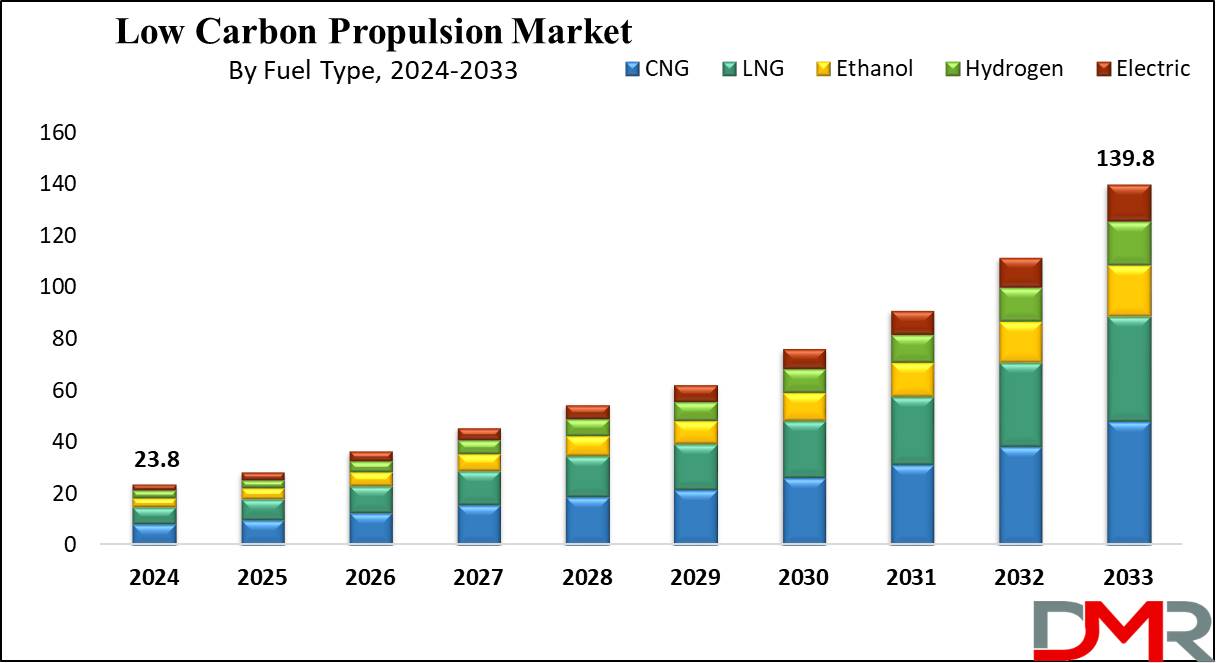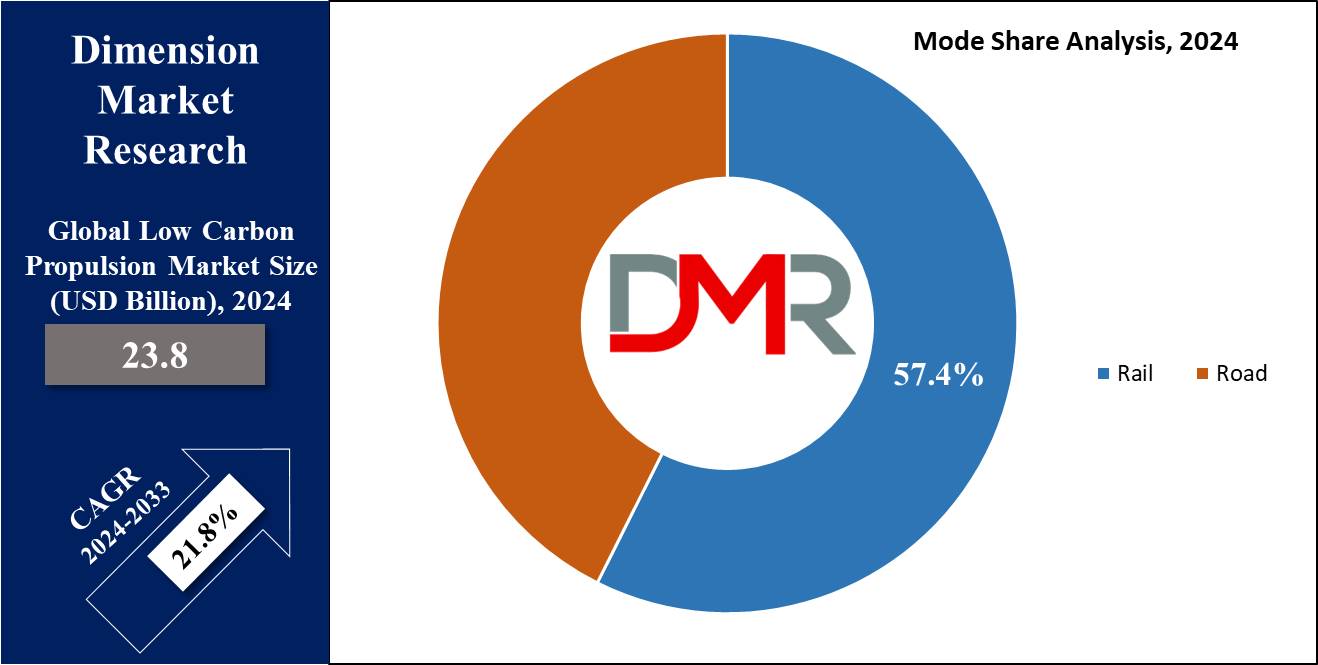New York, Sept. 19, 2024 (GLOBE NEWSWIRE) -- Overview:
The Low Carbon Propulsion Market size is expected to reach USD 23.8 billion by 2024 and is further anticipated to reach USD 139.8 billion by 2033 according to Dimension Market Research. The market is anticipated to register a CAGR of 21.8% from 2024 to 2033.
Low-carbon propulsion is an application of technologies in vehicles & transportation systems to reduce carbon dioxide (CO2) emissions and greenhouse gas (GHG) footprints, which includes many technologies, such as biofuels, electric propulsion systems, hydrogen fuel cells, and advanced hybrid technologies, with more sustainable economies.
Click to Request Sample Report and Drive Impactful Decisions: https://dimensionmarketresearch.com/report/low-carbon-propulsion-market/request-sample/

The US Overview
The Low Carbon Propulsion Market in the US is projected to reach USD 8.3 billion in 2024 at a compound annual growth rate of 20.4% over its forecast period.
The U.S. Low Carbon Propulsion market benefits from growing EV adoption, advancements in battery tech, and robust government incentives, positioning it as a key player in sustainable mobility. However, high initial costs and inadequate charging infrastructure hinder mass adoption and limit growth, especially in less developed areas.
Important Insights
- The Low Carbon Propulsion Market is expected to grow by USD 111.4 billion by 2033 from 2024 with a CAGR of 21.8%.
- The CNG is set to lead in 2024 with a majority & is anticipated to dominate throughout the forecasted period.
- The Rail segment is anticipated to lead as a mode for the Low Carbon Propulsion Market in 2024.
- The passenger car segment is set to get the largest revenue share in 2024 in the Remote Sensing Technology market.
- North America is set to have a 39.3% share of revenue share in the Global Low Carbon Propulsion Market in 2024.
Global Low Carbon Propulsion Market: Trends
- Enhanced Battery Tech: Recent breakthroughs in battery chemistry are enhancing the range and reducing costs for EVs.
- Vehicle Electrification: Better integration of electric drivetrains in many vehicle segments, from cars to trucks.
- Smart Charging Solutions: Occurrence of advanced charging technologies, like ultra-fast and wireless charging options.
- Green Financing: Rising availability of green bonds and sustainable investment funds supporting low-carbon transportation projects.
Low Carbon Propulsion Market: Competitive Landscape
The Low Carbon Propulsion market is highly competitive, marked by innovation and collaboration. Key players focus on electric, hybrid, and hydrogen propulsion technologies, develop strategic partnerships, and invest in R&D and infrastructure. The drive for sustainability and regulatory compliance fuels competition, aiming for efficient and eco-friendly solutions.
Some of the major players in the market include BYD, Honda, Tesla, Siemens, Hyundai, Toyota, and more.
Some of the prominent market players:
- BYD
- Honda
- Tesla
- Siemens
- Hyundai
- Toyota
- Nissan
- General Electric
- Cummins
- Alstom
- Other Key Players
Transform your business approach with strategic insights from our report. Get in touch to request our brochure today at https://dimensionmarketresearch.com/report/low-carbon-propulsion-market/download-reports-excerpt/
Low Carbon Propulsion Market Scope
| Report Highlights | Details |
| Market Size (2023) | USD 23.8 Bn |
| Forecast Value (2032) | USD 139.8 Bn |
| CAGR (2023-2032) | 21.8% |
| The US Market Size (2024) | USD 8.3 Bn |
| Leading Region in terms of Revenue Share | North America |
| Percentage of Revenue Share by Leading Region | 39.3% |
| Historical Data | 2018 - 2023 |
| Forecast Data | 2024 - 2033 |
| Base Year | 2023 |
| Estimate Year | 2024 |
| Segments Covered | By Fuel Type, By Mode, By Electric Vehicle, and By Rail Application |
| Regional Coverage | North America, Europe, Asia Pacific, Latin America, Middle East & Africa (MEA) |
Regional Analysis
North America is projected to lead the Low-Carbon Propulsion Market, holding over 39.3% of the share in 2024, due to its strong commitment to environmental sustainability & very strict clean energy regulations. Rising demand for eco-friendly transport and supportive government incentives are accelerating this shift. Europe is also making major strides with its ambitious carbon reduction targets, while the Asia-Pacific region is rapidly expanding due to increase in environmental awareness, supportive government initiatives, and growing demand for sustainable mobility. These factors are driving a global transition towards low-carbon transportation solutions.

By Region
North America
- The U.S.
- Canada
Europe
- Germany
- The U.K.
- France
- Italy
- Russia
- Spain
- Benelux
- Nordic
- Rest of Europe
Asia-Pacific
- China
- Japan
- South Korea
- India
- ANZ
- ASEAN
- Rest of Asia-Pacific
Latin America
- Brazil
- Mexico
- Argentina
- Colombia
- Rest of Latin America
Middle East & Africa
- Saudi Arabia
- UAE
- South Africa
- Israel
- Egypt
- Rest of MEA
Purchase the Competition Analysis Dashboard Today at https://dimensionmarketresearch.com/checkout/low-carbon-propulsion-market/
Segment Analysis:
The rail segment is anticipated to be leading the low-carbon propulsion market in 2024 due to its pivotal role in sustainable transportation and carbon reduction. Large investments in eco-friendly mass transit and advancements in hybrid and electric trains powered by renewable energy enhance rail's sustainability. Integration with intermodal solutions further minimized road congestion and emissions. Further, the road segment grows steadily, driven by demand for electric & hybrid vehicles and supportive government policies. The expansion of EV infrastructure and focus on reducing pollution position road transport as a major contributor to sustainable mobility.

Low Carbon Propulsion Market Segmentation
By Fuel Type
- LNG (Liquid Natural Gas)
- CNG (Compressed Natural Gas)
- Ethanol
- Hydrogen
- Electric
By Mode
- Rail
- Road
By Electric Vehicle
- Passenger Car
- Bus
- Off-Highway
- Two-Wheeler
By Rail Application
- Passenger
- Freight
Global Low Carbon Propulsion Market: Driver
- Government Incentives: Strong financial support & policy measures boost EV adoption and low-carbon technologies.
- Battery Technology: Developments in battery performance and affordability enhance EV appeal and efficiency.
- Infrastructure Investment: Growing EV charging networks support better market penetration and user convenience.
- Sustainable Demand: Increase in consumer preference for eco-friendly transportation drives market growth and innovation.
Global Low Carbon Propulsion Market: Restraints
- High Upfront Costs: Expensive initial investments for EVs & infrastructure can impact broad adoption.
- Limited Charging Infrastructure: Inadequate charging stations limit convenience and lower EV use, especially in rural areas.
- Technological Challenges: Ongoing development issues with battery life & efficiency can slow market growth.
- Market Fragmentation: Inconsistent policies & standards across regions create uncertainty and hinder unified market expansion.
Click to Request Sample Report and Drive Impactful Decisions at https://dimensionmarketresearch.com/report/low-carbon-propulsion-market/request-sample/
Global Low Carbon Propulsion Market: Opportunities
- R&D Investment: Increased research in clean energy technologies can create breakthroughs in efficiency and performance.
- Policy Support: Expanding government incentives & regulations favoring low-carbon technologies can drive market growth.
- Urbanization Trends: Growing cities & higher focus on sustainable urban transport solutions present new market opportunities.
- Corporate Fleets: The adoption of EVs by businesses for fleet operations provides a significant growth avenue in the commercial sector.
Recent Developments in the Low Carbon Propulsion Market
- May 2024: Subaru Corporation, Toyota, and Mazda introduced a partnership to design new engines personalized to electrification and the pursuit of carbon neutrality.
- May 2024: The German Aerospace Cent in Cologne finalized its aviation strategy focused on lowering the carbon footprint of flying, which addresses carbon and non-carbon emissions, and proposes solutions to reduce aviation's impact on climate change.
- April 2024: Terragia Biofuel unveiled that it raised a USD 6 million seed round led by Engine Ventures and Energy Impact Partners (EIP, and will use the capital to commercialize its novel biology-based approach to converting cellulosic biomass into ethanol & other products, expand its employee headcount, and initiate partnerships with major biofuel producers.
- March 2024: Mitsubishi Heavy Industries, Ltd. announced an agreement with Kellogg Brown & Root, Ltd. (KBR, Ltd.), an operating company of the first-tier American engineering firm KBR, Inc., to deliver CO2 capture technology for a low carbon hydrogen production plant.
- February 2024: Cummins Inc. launched its most efficient heavy-duty diesel engine ever. As the next product in the Cummins HELM 15-liter fuel agnostic platform, the diesel X15 would be compliant with U.S. EPA & CARB 2027 aligned regulations at launch.
Browse More Related Reports
The Global Smart Greenhouse Market is projected to reach USD 2.3 billion in 2024 and grow at a compound annual growth rate of 10.4% from there until 2033 to reach a value of USD 5.7 billion.
The Global Greenhouse Market is projected to reach USD 32.6 billion in 2024 and grow at a compound annual growth rate of 10.3% from there until 2033 to reach a value of USD 78.7 billion.
The Global Automotive Carbon Fiber Market is projected to reach USD 30.2 billion in 2024 and grow at a compound annual growth rate of 11.6% from there until 2033 to reach a value of USD 81.0 billion.
The Global Paper Packaging Material Market size is expected to reach a value of USD 419.9 billion in 2024, and it is further anticipated to reach a market value of USD 656.5 billion by 2033 at a CAGR of 5.1%.
The Global Precious Guided Munitions Market is expected to reach a valuation of USD 43.5 billion in 2024 and is anticipated to achieve a remarkable CAGR of 7.0% for the forecast period to reach a value of 79.7 billion in 2033.
The Global Crosslinking Agents Market is expected to reach a valuation of USD 7.7 billion in 2024 and is anticipated to achieve a remarkable CAGR of 5.6% for the forecast period to reach a value of 12.6 billion in 2033.
The Global Blue Hydrogen Market is expected to reach a valuation of USD 2.3 billion in 2024 and is anticipated to achieve a remarkable CAGR of 10.8% for the forecast period to reach a value of 5.5 billion in 2033.
The Global Mastic Gum Market size is estimated to reach a value of USD 730.6 million in 2024 and is expected to grow at a compound annual growth rate (CAGR) of 6.1% for the forecasted period (2024-2033).
The Global Biosimilars Market was valued at USD 25.5 billion in 2023, and it is further anticipated to reach a market value of USD 117.9 billion by 2033 at a CAGR of 16.5%.
About Dimension Market Research (DMR):
Dimension Market Research (DMR) is a market research and consulting firm based in India & US, with its headquarters located in the USA (New York). The company believes in providing the best and most valuable data to its customers using the best resources analysts into work, to create unmatchable insights into the industries, and markets while offering in-depth results of over 30 industries, and all major regions across the world. We also believe that our clients don’t always want what they see, so we provide customized reports as well, as per their specific requirements to create the best possible outcomes for them and enhance their business through our data and insights in every possible way.
